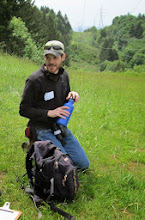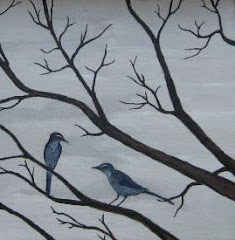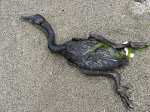The first was published several months ago in American Naturalist. Adam Tofilsky and others studied the nests of Brazilian ants (Forelius pusillus) and uncovered a darkly efficient home security strategy.

The ants build underground nests with a small opening to the outside world. As nighttime approaches, several workers bring bits of sand to close off the opening. when the opening is sealed, they kick sand over their work to hide the entrance. Cut-off from their colony, the workers wander off and die, some before the next morning when the entrance is opened from inside the nest.
The sacrifice of these workers seems like a plot from a Cormac Mccarthy novel or the Old Testament. I wonder if the oldest workers in the colony volunteer for the closing duties each night.
The second paper was recently published in Science and has been getting a lot of press lately. Phillip J. van Mantgem and others report rates of tree death in 76 undisturbed western forest stands.
The alarming finding is that mortality rates increased in 87% of study plots and the percentage of trees dying in the Pacific Northwest doubled during a 17 year period. The authors speculate that hot and dry conditions resulting from climate change have led to the increased mortality of trees. Mortality rate increases were highest in the Pacific Northwest, in mid-elevations. A variery of species were examined, but pines and hemlocks had the greatest increases in mortality.
Whatever the causes of climate change, it seems likely that forests as we know them will not exist for long. As tree species are lost from a given area, they will be replaced by trees or other plants from lower elevations or latitudes that are better adapted to the new climatic conditions. The big question for me is how birds and other animals are affected by these changes. Animals that are confined to specific habitat types will likely respond in one of three ways to changes in forest structure and composition: (1.) they will evolve new behavioral or physical adaptations to their altered habitat, (2.)they will move to higher elevations or latitudes that are more hospitable, or (3.) they will go locally or globally extinct.

I am working on a presentation for an upcoming ornithology meeting in which I predict whether certain southwestern birds will need to respond in one of the three ways to predicted climate change scenarios. I hope that we can identify habitats that are most at risk from climate change to develop management plans that will lessen the impacts to wildlife populations.
Works Cited:
Tofliski, A. et al. 2008. Premptive defensive self-sacrifice by ant workers. American Naturalist 172(5):239-244.
van Mantgem, P.J. et al. 2009. Widespread increase of tree mortality rates in the western United States. Science 323: 521-524.







No comments:
Post a Comment